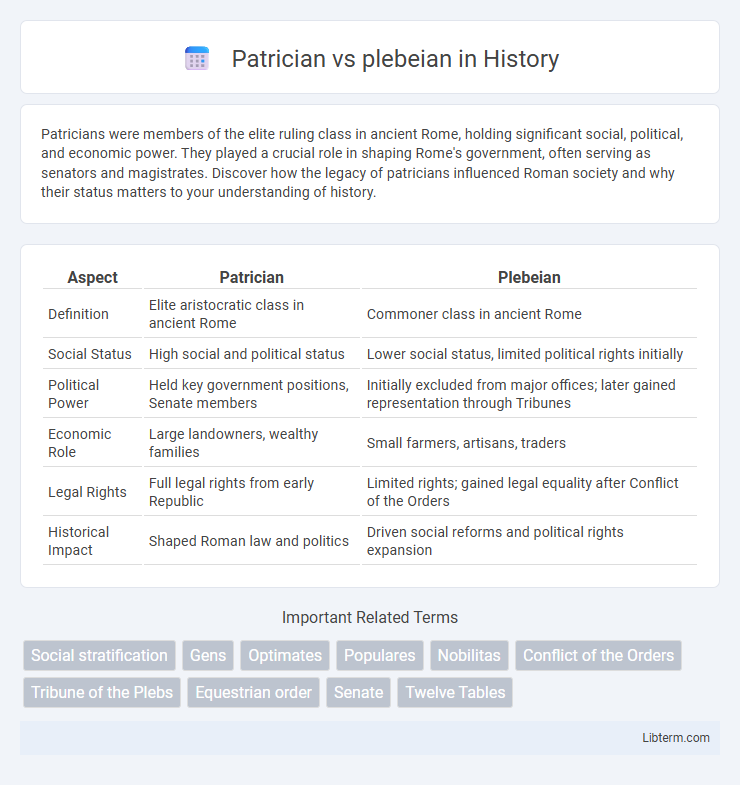Patricians were members of the elite ruling class in ancient Rome, holding significant social, political, and economic power. They played a crucial role in shaping Rome's government, often serving as senators and magistrates. Discover how the legacy of patricians influenced Roman society and why their status matters to your understanding of history.
Table of Comparison
| Aspect | Patrician | Plebeian |
|---|---|---|
| Definition | Elite aristocratic class in ancient Rome | Commoner class in ancient Rome |
| Social Status | High social and political status | Lower social status, limited political rights initially |
| Political Power | Held key government positions, Senate members | Initially excluded from major offices; later gained representation through Tribunes |
| Economic Role | Large landowners, wealthy families | Small farmers, artisans, traders |
| Legal Rights | Full legal rights from early Republic | Limited rights; gained legal equality after Conflict of the Orders |
| Historical Impact | Shaped Roman law and politics | Driven social reforms and political rights expansion |
Introduction to Patricians and Plebeians
Patricians were the elite ruling class of ancient Rome, holding political power, land, and religious authority. Plebeians, comprising the majority of the population, were commoners who initially had limited rights and political influence. The social division between patricians and plebeians shaped Rome's political structure and legal reforms.
Historical Background of Roman Society
Roman society was historically divided into two main classes: the patricians, who were wealthy, land-owning aristocrats with exclusive political privileges, and the plebeians, the common citizens comprising farmers, artisans, and merchants who initially lacked political power. This division originated during the early Roman Republic, around the 5th century BCE, when patricians held all political offices and religious authority as descendants of Rome's founding families. Over time, the plebeians fought for and gained political rights through social struggles like the Conflict of the Orders, leading to reforms such as the establishment of the Tribune of the Plebs and the codification of laws in the Twelve Tables.
Social Structure and Class Distinctions
Patricians constituted the elite ruling class in ancient Rome, owning vast estates and holding exclusive political power, while plebeians comprised the broader citizenry with limited rights and primarily engaged in agriculture, craftsmanship, and trade. Social structure was rigid, with patricians controlling the Senate and religious offices, reinforcing class distinctions through legal privileges and hereditary status. Over time, plebeians gained political representation via the Tribune of the Plebs, yet social mobility remained constrained within the stratified Roman hierarchy.
Rights and Privileges of Patricians
Patricians held exclusive rights and privileges in ancient Rome, including control over religious offices and political power in the Senate. They had the privilege to own large estates and command military forces, maintaining social dominance over plebeians. Legal protections and hereditary status ensured patricians retained influence across generations.
The Struggles and Challenges of Plebeians
Plebeians in ancient Rome faced economic hardship, limited political power, and social discrimination as they were excluded from many rights reserved for patricians. Their struggles included debt bondage, inability to hold public office, and lack of legal protections. Persistent plebeian protests led to the creation of the Tribune of the Plebs and the Twelve Tables, which gradually improved their social and political status.
Political Influence: Patricians vs Plebeians
Patricians held significant political influence in ancient Rome, controlling key offices such as consuls and senators, shaping legislative decisions through their hereditary aristocratic status. Plebeians, initially excluded from high offices, gradually gained political rights through the Conflict of the Orders, leading to the creation of the Tribune of the Plebs and the eventual passage of the Lex Hortensia, which empowered plebeian assemblies. This shift balanced political power, allowing plebeians increased representation and a voice in Roman governance while patrician dominance waned.
Economic Power and Wealth Distribution
Patricians controlled vast landholdings and wealthy estates, consolidating economic power through agriculture, trade, and political influence in the Roman Republic. Plebeians, largely small farmers, artisans, and laborers, faced economic challenges due to limited access to land and wealth accumulation. Wealth distribution heavily favored patricians, resulting in socio-economic disparities and ongoing plebeian demands for land reforms and political rights.
Key Conflicts: The Struggle of the Orders
The Struggle of the Orders was a pivotal conflict between Patricians, the aristocratic ruling class, and Plebeians, the common citizens of ancient Rome. Plebeians fought for political equality, demanding access to key offices and legal protections previously reserved for Patricians. This social struggle led to significant reforms, including the creation of the Twelve Tables and the establishment of the Tribune of the Plebs, ensuring Plebeians' rights and influencing the Roman Republic's governance structure.
Lasting Impact on Roman Civilization
The distinction between Patricians and Plebeians shaped Rome's political and social structures, leading to the establishment of the Roman Republic's system of checks and balances. Patrician control initially dominated the Senate and religious offices, while Plebeian struggles resulted in reforms like the Twelve Tables and the creation of the Tribune of the Plebs, ensuring broader representation. This dynamic tension influenced the development of Roman law, social equality, and governance models that impacted Western civilization for centuries.
Legacy of Patrician and Plebeian Divide
The legacy of the Patrician and Plebeian divide in ancient Rome shaped the foundation of social hierarchy and political rights, influencing the development of republican institutions and legal reforms such as the Twelve Tables. Patricians maintained aristocratic privileges and control over religious and political offices, while the Plebeians' struggle for inclusion led to the establishment of the Tribune of the Plebs and increased representation. This enduring conflict highlights the evolution of class dynamics and the pursuit of equity within Roman society, setting precedents for modern concepts of citizenship and legal equality.
Patrician Infographic

 libterm.com
libterm.com